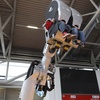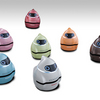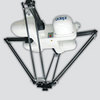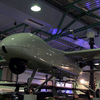Accuray Boeing Colin Angle Consumer Robotics CyberKnife CytoCare DARPA Education Financial Results Health Robotics Healthcare Robotics i.v.Station Industrial Robotics Industrial robotics International Space Station iRobot Liquid Robotics Lockheed Martin Medical Device Medical Robotics Medical robotics medical robotics Military Robotics Military robotics NASA Northrop Grumman Oceanography PackBot Remotely Operated Vehicle Research Robot Robotics ROV Schilling Robotics UAV Unmanned Aerial Vehicle unmanned aerial vehicle Unmanned aerial vehicle Unmanned Underwater Vehicle UUV
KUKA Robotics' RoboSim 4-D Simulator
October 7, 2009Taking visitors on a ride beyond the traditional 3D experience, KUKA Robotics' RoboSim 4-D simulator ride system is blowing Epcot adventurers away with the addition of a simple fourth dimension: wind.
The KUKA Robotics RoboSim 4-D Simulator ride system is part of a new exhibit at Walt Disney World's INNOVENTIONS in Epcot. In addition to the 4-D simulator, KUKA also sponsors the 2,000 square foot Rockin' Robots interactive exhibit, where guests can experience the excitement of conducting a four-piece robotic band to create a symphony of sounds using an array of instruments including cymbals, gongs, chimes and car horns.
The RoboSim 4-D Simulator creates a four-dimensional experience through 3-D robotic motion and "wind", by controlling air movements to stimulate the senses providing a more realistic simulation experience involving high speeds, quick direction changes and different climates.
According to Stu Shepherd, President of KUKA Robotics Corporation, "We are excited for the opportunity to demonstrate KUKA's unique capabilities in a market that drives progress and interest in learning."
Health Robotics Closes Another Deal
October 6, 2009Health Robotics is on a roll. In addition to recent wins in China and Australia, the company announced a five-year strategic partnership with Spanish firm Grifols International S.A. for its revolutionary CytoCare Robot. The agreement enables Grifols to add CytoCare to its prior i.v.STATION contract with Health Robotics, and serve its clientele in Mexico, Chile, Brazil, Argentina, Uruguay, Paraguay, Bolivia, Peru, Venezuela, Colombia, Ecuador, Panama, Costa Rica, Belize, Nicaragua, El Salvador, Honduras, Guatemala, Surinam, French Guyana, and Guyana.
The contract between the companies also adds Mexico to Grifols' i.v.STATION distribution and support rights.
"We are very excited to have been chosen by Health Robotics as their exclusive CytoCare partner in Latin America, and to add one of the largest Latin American markets [Mexico] to our i.v.STATION distribution rights.
Dynamics Research Awarded $1.6 Million Air Force UAV Contract Work
October 6, 2009In addition to L-3 Communications' recent contract win to provide SOCOM with UAV technology and systems, Dynamics Research also announced that it had been awarded a new delivery order under the Logistics Maintenance and Supply Support Services (LMSS) contract with a value of $1.6 million dollars for a one year period of performance.
According to an official company release, the effort will provides the 703rd Aeronautical Systems Group (AESG) Predator/Reaper Unmanned Aerial Vehicle Program Office, with multifunctional capabilities including test and evaluation engineering, foreign military sales engineering, logistics, program management and analytical services.
This past August, Dynamics Research was awarded two task orders with a combined value of $14.3 million for services in support of the Aeronautical Systems Center at Wright-Patterson Air Force Base in Ohio. The company will provide the 303rd Reconnaissance and 516th Mobility Aeronautical Systems Wings a wide array of support services.
Training in the Desert With an Eye to Space
October 2, 2009Last week, TMCnet editor Marisa Torrieri covered the latest in NASA's technology development tests on two of its prototype lunar rovers that will help it with future research.
According to Torrieri, the two-week long Desert Research and Training Studies (D-RATS) training exercise, "...helped NASA to analyze and refine technologies and procedures in extreme environments on Earth."
According to the group's Web site, D-RATS is a NASA-led team of research partners working together to prepare for human-robotic exploration. The group conducts tests in rugged areas such as the Arizona desert in order to develop the necessary levels of technical skills and experience to help realize the goals of NASA's Constellation Program.
Constellation is a current human spaceflight mission within NASA, which encompasses plans to develop spacecraft and booster vehicles to replace the Space Shuttle and send astronauts to the Moon and possibly to Mars as well.
Fish Behavior Inspires Collision Avoidance Robot
October 2, 2009Fish-inspired collision avoidance technology is at the center of Nissan Motor's new "EPORO" robot car, a concept vehicle that is designed to travel in a group of similar vehicles, avoiding obstacles and each other. Developers have the robots mimicking the patterns of a school of fish, which helps avoid collisions.
Nissan plans to showcase the technology -- and a group of six new EPORO robot vehicles October 6-10 at CEATEC JAPAN 2009, an exhibition of cutting-edge electronic and information technologies.
According to the company, three rules of fish behavior were modeled and applied to EPORO's driving control. Fish recognize the surroundings based on lateral-line sense and sense of sight and form schools based on these behavior rules. A laser range finder is used for lateral-line sense, while ultra-wideband (UWB) communications technology is utilized for the sense of sight.
The communication technologies being showcased in EPORO enable the robot cars to share the position and information of others within the group.
"We recreated the behavior of a school of fish making full use of cutting-edge electronic technologies," said Toshiyuki Andou, Manager of Nissan's Mobility Laboratory and principal engineer of the robot car project.
ABB Robotics to Enhance Vincennes University Technical Training
October 1, 2009In an item on TMCnet this week, industrial robots supplier ABB Robotics announced a partnership with Vincennes University to enhance the Indiana college's vocational and technical robotic training.
The deal would also reportedly give ABB an authorized training facility in the central Midwest.
Vincennes is no stranger to teaching students about robotics. The University launched its original Associate of Science Degree in Robotics Technology in 1983, and since then has expanded its related curriculum to include Computer-Integrated Manufacturing which includes Hydraulics and Pneumatics, Programmable Logic Controllers (PLCs), Automated Process Control, Elecrical Machine Control, Mechanical Drive Systems, Motor Control Systems, Robot Programming and Servicing, Industrial Networking, plus other courses in automation.
Under the agreement, 29 ABB robots and related work cells, software and controllers will be installed into VU's newly opened $9 million industrial training facility, the Indiana Center for Applied Technology (ICAT).
Engineers Look to Improve Military Robots
October 1, 2009The Boston Globe has a story today about Bedford, MA-based iRobot, and how the company is working on improved technology for its PackBot line of battlefield robots.
According to the report, iRobot has received a grant from the US Department of Defense's Joint Ground Robotics Enterprise, but the company declined to say how much the grant was worth.
And staying with the military robotics theme, a Star-Ledger piece that appears on NJ.com describes how engineers at Picatinny Arsenal in Dover, NJ are working on a couple of wheeled robotic vehicles that are designed to help save soldiers' lives.
The Star-Ledger quotes Bhavanjot Singh, project officer at Picatinny Arsenal, who tells the paper that the two vehicles, the MS1 and MS2, are modified versions of the "Ripsaw."
The Ripsaw is a high-speed, tracked vehicle designed by Howe and Howe Technologies specifically for US Army unmanned ground vehicle (UGV) Application. The Ripsaw was recently awarded Popular Science Magazine's "Invention of the Year" honors.
According to the article in the Star Ledger, Picatinny engineers are looking to integrate a weapons package. The Ripsaw can reportedly be fitted with an M-240 machine gun, or a non-lethal variant that could be used for crowd disbursement.
According to pictures on the Howe and Howe Web site, the Ripsaw is no shrinking violet. For a full gallery of the pictures we've sampled here, click through to this page or this page.
Adept Unveils New Food Handling Robot
September 30, 2009Pleasanton, CA-based Adept Technology has announced that its new robot for high-speed food handling, the Adept Quattro s650HS, which has been accepted by the USDA, will be on display at Pack Expo 2009. According to the company, Quattro s650HS is the only USDA Accepted parallel robot available for meat and poultry processing.
The Pack Expo show will be held in Las Vegas, October 5-7.
Rush LaSelle, director of global sales and marketing for Adept Technology, Inc., said, "The Adept Quattro s650HS has been designed to give food packagers the highest possible speeds for raw-food handling, without compromising cleanliness and hygienic standards."
The Quattro line is specifically designed for high-speed manufacturing, packaging, material handling, and assembly applications. The robot features a unique four-arm kinematic, which is designed to enable higher speeds and faster accelerations.
Russian Army Considering UAVs
September 30, 2009An item over at defpro.com says that the Russian Army is planning to add tactical unmanned aerial vehicles (UAVs) to its reconnaissance battalions. In an interview with ITAR-TASS quoted on the defpro.com site, General Vladimir Boldyrev said that Russia is planning to equip the units with remotely piloted tactical aircraft.
According to the General, the first UAVs to be deployed would have ranges of 25 to 100 kilometers and that Russia might subsequently introduce long-endurance tactical UAVs with ranges up to 500 kilometers. Boldyrev said the longer range UAVs would likely be operated by the Air Force.
In 2009, Russia signed a contract with Israel for the purchase of a number of samples of unmanned aerial vehicles for military purposes, valued at approximately $50 million. However, the General indicated in the interview that Russia would soon begin development of its own UAVs. The development of domestic unmanned aircraft for intelligence and other activities is reportedly being carried out at the Yegorievsk military base.
New Group Aims to Curb Military Use of Robots
September 30, 2009According to a report in the New Scientist, a group of experts has joined forces to promote a campaign to limit the use of robotic military hardware, calling for autonomous weapons systems to be banned from space and that robotic systems should be banned from carrying nuclear weapons.
Roboticist Noel Sharkey at the University of Sheffield, UK; physicist Jürgen Altmann of Dortmund University of Technology, Germany; Robert Sparrow of the Centre for Human Bioethics, Monash University, near Melbourne, Australia; and philosopher Peter Asaro of Rutgers University in New Brunswick, New Jersey met in Sheffield in early September to discuss a series of issues including the group's ethical concerns regarding military systems that make decisions independently of human operators.
At the conclusion of the group's meeting, the International Committee for Robot Arms Control (ICRAC) was formed.
In an interview with New Scientist, Sharkey voiced his concerns, saying, "We seem to be rushing headlong into the development of autonomous weapons systems without any real concern for the long-term impact on civilian populations."
Many nations either currently field or have plans to deploy remotely controlled, unmanned vehicles, robots, and aerial vehicles. One thing that most of these systems have in common is the inclusion of a human operator. ICRAC is concerned that the next generation of robots being developed for military purposes will remove direct human oversight with potentially devastating consequences.
To that end, the organization hopes to inspire a set of regulations that would apply to military robotics, much the same way current regulations govern the use of nuclear and biological weapons.
Health Robotics Announces SINOPHARM Deal
September 28, 2009Last week we wrote about Health Robotics' expansion into the Australian market and their deal with Device Technologies Australia.
Today, the company announced an exclusive five-year strategic agreement with China National Pharmaceutical Foreign Trade Corporation (SINOPHARM Foreign Trade), which will distribute and support the company's CytoCare and i.v.STATION Robots.
SINOPHARM is a wholly owned People's Republic of China Government (PRC) company.
The arrangement is designed to enable SINOPHARM to safely, accurately and cost-effectively automate the preparation of hazardous and non-hazardous IV Admixtures in China, including Hong Kong and Macao.
"Health systems and government entities in China are determined to deliver the best health care and medication management to their people. The expansion of CytoCare and i.v.STATION into China will fulfill our Government's health care strategic direction and improve the provision of medical services in our country," stated Wu Jian Feng, General Manager of SINOPHARM Foreign Trade's Healthcare Division.
Werner Rainer, Health Robotics' CEO was excited to announce the deal.
Fighting Fire with Robots
September 28, 2009Robots have long been viewed as a safer alternative to keep humans out of harm's way when it comes to deploying into hostile environments, be it in a military setting or other unsuitable environment. Now, news comes to us from South Korea that local firemen will soon be working alongside a pair of robotic firefighting machines that can be deployed into extreme conditions.
The two automated, wheeled robots will be tested in fire stations in Daegu, south of Seoul, and the trial period will run through November with 45 firehouses participating.
If all goes as planned, the firefighting robots will be deployed nationwide, according to officials at the Ministry of Knowledge Economy.
The first machine -- dubbed "Fire Spy Robot" -- was developed by Hoya Robot, and measures 12.5 centimeters in diameter (about 5 inches) and weighs 2kg (~4.4 lbs.). Its operator can maneuver the robot and see into the environment via an installed camera.
The second vehicle being tested, which was developed by DRB Fatec is larger, at 88 centimeters tall (34.6 inches) and 85 centimeters wide (33.5 inches).
Honda Unveils U3-X Personal Mobility Device
September 25, 2009Honda has developed a new personal mobility technology and announced a compact experimental device, the U3-X,designed to provide free movement in all directions -- forward, backward, side-to-side, and diagonally.
The new device builds on the robotic research the company has developed in conjunction with its work on the ASIMO bipedal humanoid robot project. The U3-X also incorporates Honda's omni-directional driving wheel system (Honda Omni Traction Drive System, or HOT Drive System), which enables movement in all directions, including not only forward and backward, but also directly to the right and left and diagonally.
For a video demonstration visit Honda's Web site here.
Honda plans to continue research and development of the device and will conduct experiments in a real-world environment to determine practical uses of the device.
Seegrid Among Tech Firms Highlighted During G-20 Summit
September 25, 2009As the G-20 descends on Pittsburgh this week, some local companies are taking advantage of the visit by the finance ministers and central bank governors to showcase their capabilities.
One example is Seegrid Corporation, a robotics company that develops industrial mobile robots for use in the material handling industry.
Seegrid, in cooperation with the Allegheny Conference on Community Development and the Pittsburgh G-20 Partnership, will host visits from the media and dignitaries to demonstrate Seegrid's robotics capabilities for real-world business applications.
The company's vision-guided robots automate the movement of product, resulting in improved flexibility, reduced operating costs and increased scalability.
"Seegrid represents the rebirth of Pittsburgh as a global robotics and technology hub," said Brad Wyland, Director of Product Strategy, Seegrid Corp. "We are not only showcasing how we drastically reduce operating costs for warehouse managers, but Seegrid also represents the opportunity that many high-tech companies have found in Pittsburgh -- the opportunity to draw from the world-renowned academic communities as well as the talent-rich labor force in order to build out the new face of business for this rapidly growing city."
Seegrid was founded in Pittsburgh in February 2003 as a spinout of Carnegie Mellon University's Robotics Institute.












